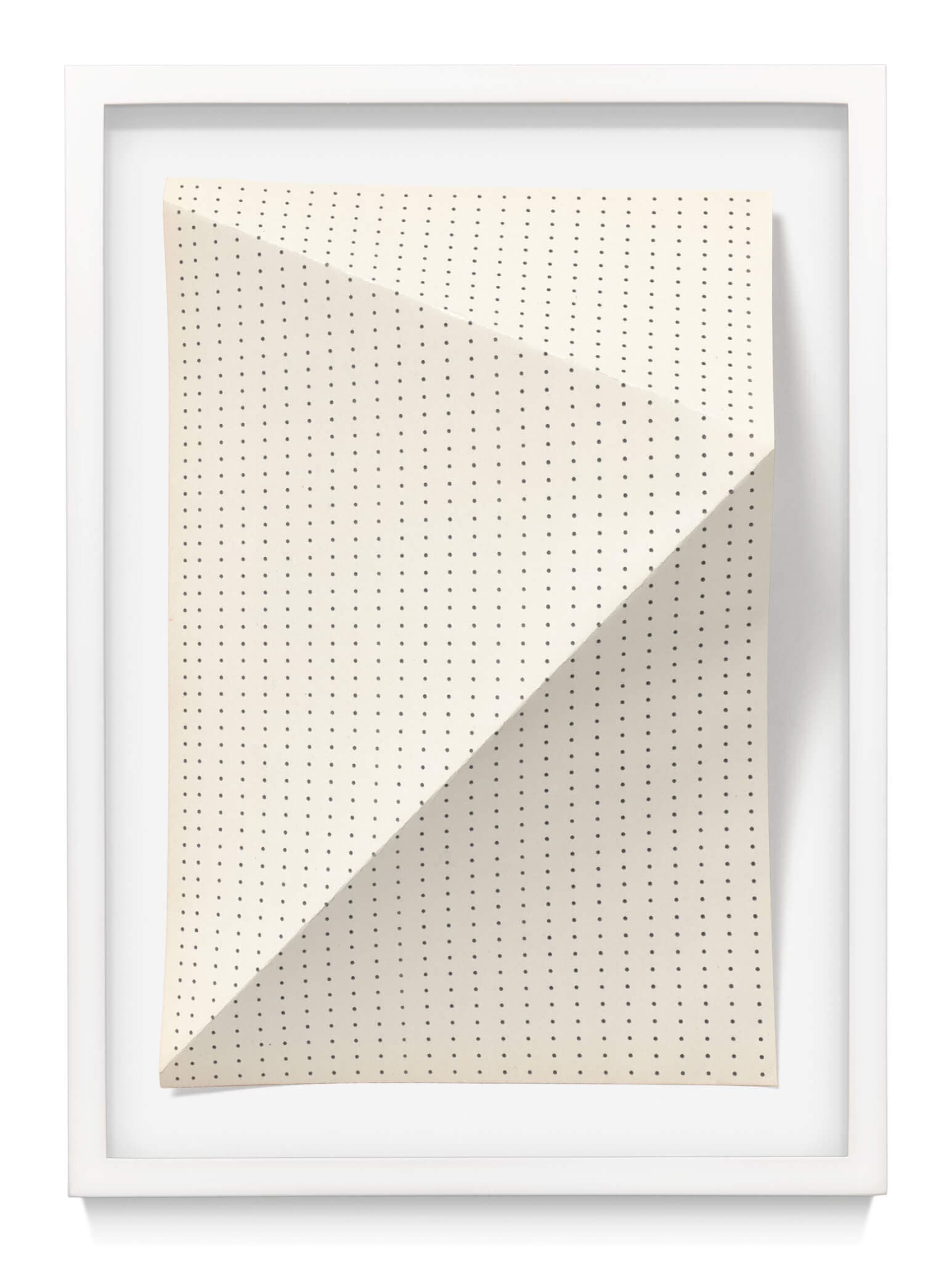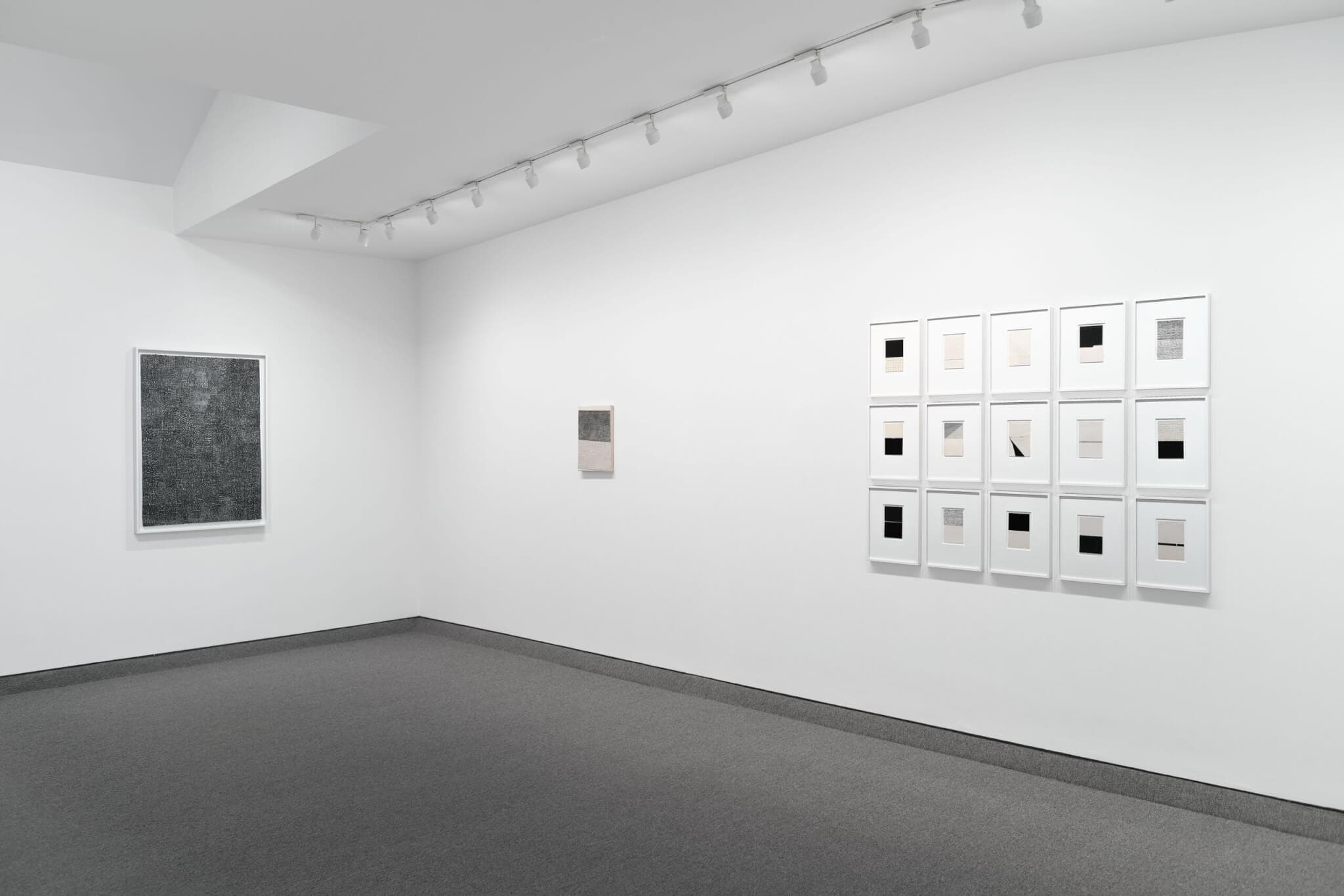The artist Victoria Burge is inspired by paper and found surfaces that show intimate signs of use—a curious note, cut, fold, smudge, bend, or erasure. Her process of looking at and responding to objects and manuscripts defines her practice. This year, Burge is a Smithsonian Artist Research Fellow in the archives at Cooper Hewitt, Smithsonian Design Museum, and the Harvard–Smithsonian Center for Astrophysics, working with curators to find and photograph evocative notations on paper. With the curators at the Smithsonian, she goes into the archives for a few hours at a time to examine items they’ve identified together in advance. The notebooks kept by astronomers in the late 1800s and early 1900s, now stored in the Cabot Science Library at Harvard, mostly contain numbers and calculations. But occasionally there are elaborate diagrams such as an illustration of a solar spectrum on decimal graph paper that shows what resembles a flag adorned with irregular diagonal lines—perhaps an indication of electromagnetic radiation emitted by the sun. Sometimes, the astronomers would modify the pages to create more space to work, add pockets, or make intricate shapes by cutting out unwanted information. At Cooper Hewitt, Burge paged through a book of hand-drawn patterns, among other items, for use on a loom passed down by one family of weavers during the 1700s.
“Even though these were scientists and textile designers, they felt like artists to me,” Burge told me in an interview earlier this month at Krakow Witkin, where her first show at the Boston gallery includes works that explore graphic tensions and the mutability of line and shape. The fellowship at the Smithsonian helped to fuel many of the works on display.

Portrait of Victoria Burge by Ben Rosenzweig. Courtesy of the artist.
“An inevitable element of delight when working within archives and libraries is discovering an unexpected three-dimensional object within the pages of a book,” Burge explained. “These artifacts—often folded papers haphazardly tucked into the back of a notebook, stuffed between pages, or quickly tipped in with whatever sticky substance was at hand, deeply flattened from time and pressure, and usually, if particularly lucky, containing a sketch, symbol, sentence, or code—create a moment of intimate connection with the long-ago author.” Burge’s Landscapes & Atmospheres (2024), a grid of fifteen minimalist pieces featured centrally on the gallery’s main wall, suggests these kinds of finds. One resembles compressed origami, another a message in Braille, another a plan for wonky steps leading to a void.

Victoria Burge, Sterope, 2024. Risograph and pencil on paper. Signed verso. Paper size: 8 3/4 x 5 7/8 inches. Frame size: 11 3/8 x 8 3/8 inches. © Victoria Burge. Photos courtesy of the artist and Krakow Witkin Gallery.

Victoria Burge, Pleione, 2024. Typewritten ink on folded paper. Signed verso. Paper size: 9 x 6 inches. Frame size: 11 1/2 x 8 1/2 inches. © Victoria Burge. Photos courtesy of the artist and Krakow Witkin Gallery.
In Sterope (2024), a pattern of dashes forms a grid of squares. The margins at the top and left are uneven. Printed askew, the pattern—a device from another time, the kind of template that was well-used when more clothes were handmade—runs to the right edge and the bottom of the 8 ¾ x 5 ⅞ inch page. With a pencil, Burge filled about half of the squares with neat circles such that a loose and wavy chevron pattern emerges when viewers stand back from the work. Across the gallery and about five times larger than Sterope, Star Data II (2024) is a tight and extensive variegated gray-black network of small boxes without any evident overall pattern. It could suggest skyscrapers in a dense cityscape or an earnest researcher’s attempt to impose a grid on the night sky. As Burge noted, “Both astronomers and weavers use grids to organize their information.” And, grids are abundant in the show at Krakow Witkin. For Electra (2024), Burge cut one apart and reconfigured it out of sync, the pieces at off angles like sections adrift—parts without the benefit of gravity to keep them attached. She started Star Data after considering réseau plates at Harvard, which use grid marks that help facilitate astronomical measurements. Points of negative space in her drawing refer to stars. “The grid works here as a reliable marker of magnification, focus, distance, and orientation,” Burge told me during a later conversation on Zoom. “I think of the grid as a finding tool, a guide, an infrastructure where organization or disorganization can take shape.”
After taking in many different types of grids through her research, Burge was struck one day by the elegance and simplicity of a three-by-two box grid. Her work, Atlas (2024) is a set of three boxes on top of a slightly larger, nearly identical set. Lines primarily originate and end at the corners of the boxes, making triangle, diamond, and kite shapes inside. Burge created the horizontal and vertical lengths with a typewriter by repeating and overlapping dashes. For the rest of the lines, she used a ruler and pencil or ink. At points—the topmost left and right sides of the drawing, for example—elements almost converge but do not. In a few cases, they seem to over- or undershoot corners, touching instead a flat edge. There are also two erased lines. “I try to hold onto the experience of looking at something for the first time, the initial way I respond to the shapes I’m seeing,” Burge explained. “It’s those shapes that I try to take into my work. What I hold onto is the weight of the line … the different tones of the paper … a visceral feeling.”
“The narrative behind the information I am looking at fascinates me,” Burge continued, “but my first concern is the immediate reaction, looking at objects and images in their abstraction, without context, just the formal elements—shape, line, point, space, tone, weight, energy.” She describes a finished work as one that vibrates.

Victoria Burge, installation view of various untitled works, all 2024. Chalk, engraving, and oil paint on 19th Century schoolhouse slate. Various dimensions. © Victoria Burge. Photos courtesy of the artist and Krakow Witkin Gallery.
Suggesting movement, connection, and perhaps vibration, Vega (2024) is typographical and topographical. Typewritten periods—dots running almost edge to edge—make an expanse of ellipses. For the left half of the piece, Burge typed and then turned the paper on its side so that the dots appear to run vertically; on its right, she typed on a separate piece of paper and then attached it. The dots run horizontally. Diagonal folds from near the top-center to the bottom corners of Vega create a tent-like form. There’s a section without dots where an opening would be if this were a tent. A red-brown pencil line extends down the center of the piece. Before the line reaches the bottom of the page, it turns right. Although this work is abstract, its title refers to a grouping of three bright stars—Altair, Deneb, and Vega—known as the “Summer Triangle” because, easily visible during summer months in the Northern Hemisphere, they would form a triangle if connected by an imaginary dotted line.
Burge leads a quiet life, maintaining her studio in a historic New Hampshire mill town a little under two hours by car from Boston. “There’s a post office, a general store, and textile buildings that house offices and artist studios. It’s extremely rural and very beautiful with not a lot of distraction, which is perfect,” she shared with me at the gallery. “When you walk into my building, you can actually still smell the wool. My studio is directly over the falls that used to power the mill. You feel the energy of the past there.”
The quiet life in New Hampshire is worlds away from her upbringing in New York City. Burge went to elementary school around the corner from Lefebre Gallery, her grandparents’ gallery that specialized in European modern art on the Upper East Side. When she and I talked in Boston, she recalled having afternoon snacks in the back room in the 1980s, its walls adorned with gestural European expressionist paintings. Later, she studied art history and horticulture, contemplating a backup career in landscape design before committing to art full-time. Her experience at the gallery was formative, though. Starting in the 1960s, her grandparents introduced the work of European artists, many of whom had not shown in the United States before, including Asger Jorn and Pierre Alechinsky. Although their sometimes raucous sensibilities differ greatly from hers, Burge also identifies aesthetic affinities: Jorn painted on top of found paintings, Alechinsky on top of maps. These acts influenced Burge, who has works on chalkboards and on antique papers at Krakow Witkin, and has often responded to star maps.

Victoria Burge, installation view, Krakow Witkin Gallery, 2025. © Victoria Burge. Photos courtesy of the artist and Krakow Witkin Gallery.
Burge also developed a friendship with the artist Horst Antes, another artist her grandparents represented. In her late twenties, she visited the German artist, forty years her senior, at his home in Italy with her mother. In the house, art was everywhere; Antes drew in many of his books and across his walls. “Horst showed me,” Burge reflected, “that the tools one needs are everywhere.”
“Both artists and scientists are deep observers. It takes close looking to make discoveries, to study the stars, to make formulas that are then used to measure distances,” Burge remarked and added that in art school, the first thing students commonly learn is drawing from observation. She told me about the work of Lorraine Daston, a scholar who offers a history of observation, starting out with shepherds and sailors who contemplated the stars. Daston points out too, that observation, in addition to taking time and dedication, also creates time. “One observes lunar eclipses and also observes the holy days of the church,” Daston once told a university crowd in Sweden. Throughout history, Daston argues that “to be observant, in both senses of the word, was to mark time, over and over again.”
Burge marking time at Harvard is especially meaningful because of the work of the Harvard Computers who are finally becoming better known. Who are the Harvard Computers? In Burge’s words: “The Harvard Computers were a group of pioneering women scientists. Annie Jump Cannon, for example, developed a spectral classification system that is still used today. Henrietta Leavitt created a method to measure distances between stars. Cecilia Payne-Gaposchkin discovered that stars are made mostly of hydrogen. These women dedicated their lives to science while advancing women’s roles in the fields of both science and academia. In the 1800s and early 1900s, the Computers were not allowed to work alongside men. The men were allowed to work in the observatory; the women worked at desks during the day. In the late nineteenth and early twentieth centuries, the Harvard Computers were challenged to make sense of—and give meaning to—patterns they found within the stars, just as textile designers working at approximately the same time constructed and made sense of the patterns that produced their fabrics.”
Blurring lines between science and art and working more than a hundred years later, Burge takes these weavers and astronomers as her predecessors and the formal elements of their mark-making as abstractions and signposts for her own art-making.
“Victoria Burge” is on view at Krakow Witkin Gallery, 10 Newbury Street, Boston, through February 15, 2025.






